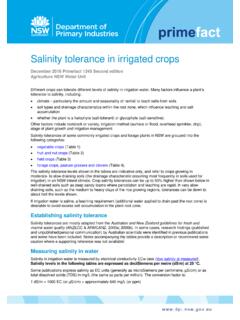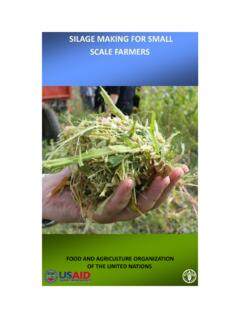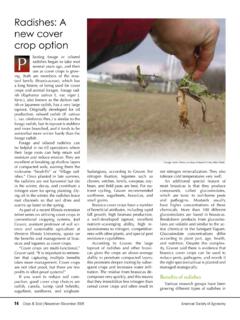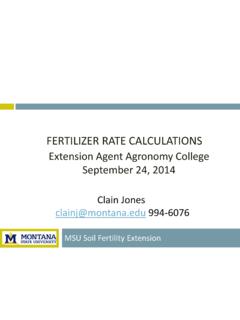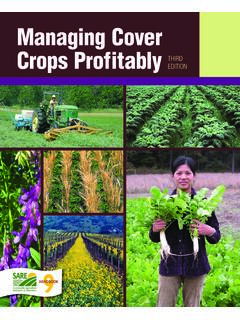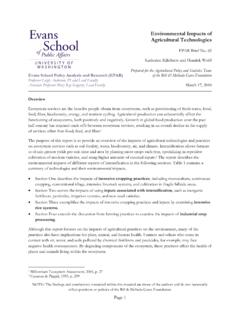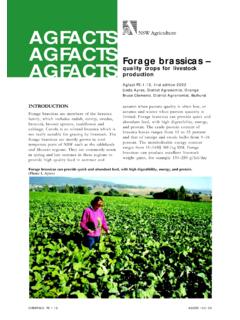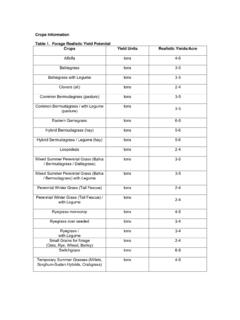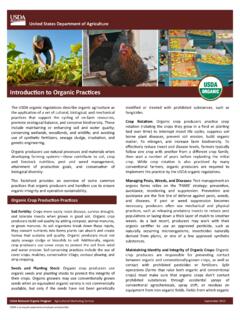Transcription of FAO IRRIGATION AND DRAINAGE PAPER 24
1 Atuirementsrevi sed1977 FOOD AND AGRICULTURE ORGANIZATIONOF THE UNITED NATIONSROMEFAO IRRIGATION AND DRAINAGE PAPER24 FAO IRRIGATION AND DRAINAGE PAPERclu Mims for [preck'dngi:e[r [aqukramernmbyj. drenbos(2L.,revised1977water management specialistland and water development divisionfaoandW. O. PrErfg" coreamN:anr1isTigadzqiisrdivevzKyoaNcinT je,davis, california, ,in consultationa. thcautthEieE: gsbar-dc<, dastane 7,D(AF: c. van den be., ashINDscl ( , field sFOOD AND AGRICULTURE ORGANIZATION OF THE UNITED NATIONSRome 1977 SUMMARYThis publication is intended to provide guidance in determiningcrop waterrequirements and their application in planning, design and operation presents suggested methods to derive crop water use of four well-known methods for determining such requirements is definedto obtain reference crop evapotranspiration (ETo), which denotes the level of evapo-transpiration for different climatic methods are the , the Radiation, the Penman and Pan Evaporation methods, each requiringa different set of climatic derive the evapotranspiration for a specificcrop, relationships between crop (ETcrop) and reference cropevapotranspiration (ETo) are given in Part I.)))]]]
2 2 for different crops, stages of growth,length of growing season and prevailing climatic conditions. The effect of localconditions on crop water requirements is given in Part ;this includes localvariation in climate, advection, soil water availability and agronomic and irrigationmethods and procedures are presented together with detailed discussion on selection and calibration of the preSented methodologiestogether with the data sources is given in Appendix II. A computer programme onapplying the different methods is given in Appendix 11 discusses the application of crop water requirements data in irriga-tionproject planning, design and II. 1 deals deriving the fieldwater balance, which in turn forms the basis for predicting and peakirrigation supplies for general planning purposes. Attention is given to irrigationefficiency and water requirements for cultural practices and leaching of methods are presented to arrive at field and scheme supply schedules withemphasis towards the field water balance and field IRRIGATION management.
3 Criteriaare given for operating the canal system using different methods of water delivery,and for subsequent design parameters of the are made inPart on refinement of field and project supply schedules once the project is presented guidelines are based on measured data and experience obtainedcovering a wide range of practical, technical, social econo-mic considerations will, however, affect the planning criteria and a critical attitude should still be taken when the IDENTIFICATION AND PRELIMINARY and Peak Project Supply water IRRIGATION requirements: effective rainfall, groundwatercontribution, stored .soil requirements:leaching requirements, of calculation of seasonal and peak project supplyrequirementsPROJECT and Project Supply IRRIGATION schedules: depth of IRRIGATION application, IRRIGATION application interval, calculation of field IRRIGATION supply schedules: surface, sprinkler and operation of supply system: continuous, rotational,supply on calculation of project design and operationPROJECT IAppendix IIAppendix IIIA ppendix IVAppendix VAppendix VITABLE OF CONTENTSS ummaryTable of ContentsList of TablesList of FiguresConversion FactorsClimatological NometiclaturePART I-CALCULATION OF CROP WATER REQUIREMENTSCALCULATION OF REFERENCE CROP Evaporation MethodSELECTION OF CROP COEFFICIENTFACTORS AFFECTING CROP : variation with time, distance, size of irrigationdevelopment, advection, Water: level of.
4 Soil water, groundwater, salinity,water and crop of IRRIGATION :surface, sprinkler, drip or trickle, sub-surface Practices: fertilizers, plant population, tillage, mulching,windbreaks, anti-transpirantsPART II-APPLICATION OF CROP WATER REQUIREMENT DATA IN IDENTI-FICATION , DESIGN AND OPERATION OF IRRIGATION PROIECTS67 Refinement of Field Supply Schedules: adaptive research, datacollection, project monitoringApplication of Field IRRIGATION DataPersons and Institutes ConsultedBackground and Development of Methods to Predict Reference CropEvapotranspirationComputer Programme for Estimation of Reference Crop EvapotranspirationGlossaryReferencesCons tants for the Radiation Equation Rs = (a + b njol)Ra338153035555559626568686971727681 8383838690961001021021041071081201331371 44 LIST OF daily percentage (p) of annual daytime hours for different latitudes6 Extra terrestrial radiation (Ra) expressed in equivalent evaporation in mm/day12 Mean daily duration of maximum possible sunshine hours (N) for differentmonths and latitudes13 Values of weighting factor (W) for the effect of radiation on ETo at differenttemperatures and altitudes13 Saturation vapour pressure (ea) in mbar as function of mean air temperature(T)
5 In oC21 Vapour pressure (ed) in mbar from dry and wet bulb temperature data in C(aspirated psychrometer)21 Vapour pressure (ed) in mbar from dry and wet bulb temperature data in C(non-ventilated psychrometer)22U2 Values of wind function f(u) = (1 + Tdd) for wind run at 2 m height in km/day23 Values of weighting factor (1-W) for the effect of wind humidity on ETo atdifferent temperatures and altitudes24 Values of factor (W) for the effect of radiation on ETo at differenttemperatures and altitudes24 Extra terrestrial radiation (Ra) expressed in equivalent evaporation in mm/day25 Mean daily duration of maximum possible sunshine hours (N) for differentmonths and latitudes26 Conversion factor for extra-terrestrial radiation (Ra) to net solar radiation(Rns) for a given reflection oc of and different ratios of actual to maximumsunshine hours (1- + n/N)27 Effect of temperature f(T) on longwave radiation (Rnl)27 Effect of vapour pressure f(ed) on longwave radiation (Rn1)27 Effect of the ratio actual and maximum bright sunshine hours f(n/N) onlongwave radiation (Rnl)27 Adjustment factor (c) in presented Penman equation28 Ratios between evaporation from sunken pans mentioned and from Coloradosunken pan for different climatic conditions and pan environments33 Pan coefficient (Kp) for Class A pan for different groundcover and levels ofmean relative humidity and 24 hour vrind34 Pan coefficient (Kp) for Colorado sunken pan for different groundcover andlevels of mean relative humidity and a hour wind34 Approximate range of seasonal ETcrop in mm36 Crop coefficient (kc)
6 For field and vegetable crops for different stages ofcrop growth and prevailing Climatic conditions40 Length of growing season and crop development stages of selected fieldcrops;some indications42kc values for alfalfa, clover, grass-legtimes and pasture45 Pagekc values for bananas46kc values for citrus (grown in predominantly dry areas with light tomoderate wind)47kc values for full grown deciduous fruit and nut trees49kc values for grapes (clean cultivated, infrequent IRRIGATION , soil surfacedry most of the time)50kc'values for rice51kc values for sugarcane52kc values for aquatic weeds and coefficients for open water54 Tolerance levels of crops to high groundwater tables waterlogging60 Critical periods for soil water stress for different crops63 Project planning stages and IRRIGATION supply data67 Average monthly effective rainfall as related to average monthly ETcropand mean monthly rainfall75 Effect of IRRIGATION water quality on soil salinity, permeability and toxicity77 Crop salt tolerance levels for different crops78 Conveyance (Ec), field canal (Eb), distribution (Ed) and field applicationefficiency (Ea)80 Relation between soil water tension in bars (atmospheres) and available soil-water in mm/m soil depth86 Generalized data on rooting depth of full grown crops, fraction of availablesoil water (p) and readily available soil water ( )
7 For different soil types(in mm/m soil depth) when ETcrop is 5- 6 mm/day88 Average intake rates of water in mm/hr for different soils and .correspondingstream size 1/sec/ha91 Size of basins and stream size for different soils93 Length of furrows and stream size for different soil type, land slopeanddepth of water application93 Size of borders and stream size for different soil t3rpe and land slope(deeprooted crops)9344 .Operating figures for some sprinklers (square pattern)94 Flow rate per drip emitter (qe) in l/hr, continuous flow, fordifferent ETcropsand number of emitters per ha95 Flow rate per tree, continuous flow, for differentETcrop and tree spacing 1/hr95 Surface area wetted (w) in m2 for differentemitter flow and soil infiltrationrateLIST OF FIGURESP rediction of ETo from Blaney-Criddle f factor for differentconditions ofminimum relative humidity, sunshine duration and day timewindPrediction of ETo from for different conditions ofmean relativehumidity and day time wind14 Illustration of the radiation balance18 ETcrop as compared to ETo35 Sugarbeets.
8 Kc values for different sowing dates36 Average kc value for initial crop development stage as related to level ofETo and frequency of IRRIGATION and/or significant rain38 Example of crop coefficient curve39kc values for alfalfa grown in dry climate with light to moderate wind and withcuttings every four weeks;one heavy IRRIGATION per growth period, a weekbefore cutting45 Frequency distribution of mean daily ETrye grass; frequency distribution of1 to 30 day mean ETrye grass during peak period56 Ratio peak and mean ETcrop for different zlimates during month of peakwater use57 Change in ETo with from ocean, California57 Change in Epan (Hudson) for cross-section over cotton Euid fallow fields factor for ETcrop when determined using chmatic data collectedoutside or prior to IRRIGATION development for different sizes of irrigatedfields under arid and moderate wind conditions58 Mean actual ETcotton over the IRRIGATION interval for different durations ofirrigation interval and for different ETcotton levels60 Relation between ETgrass and matter production from pastures atdifferent latitudes61 Relationships between relative yield and relative ETcrop for non-foragecrops, corn and virgin cane62 Example of rainfall probability calculation74 Contribution of to moist root zone in mm/day76 Monograph showing relation between depth of IRRIGATION , area irrigated,volume of IRRIGATION water.
9 Supply duration and stream size91 Page7 CONVERSION FACTORSL engthVelocity1 knot= foot= inch= yard= statute foot/min= US naut. Int. naut. mile= mile/min=2 682cm/sec= m/sec (24 hr)= foot/sec (24 hr)= in2= mile/hour (24 hr)= ft2= knot (24 hr)= yd2= acre= sq. stat. mile= atmosphere7 6cm Hg1a inch Hg= in3= inch H20= cm31 Hg1 ft3= (1)1 Hg1 gallon (1JS)= gallon (Imp.)= to equivalent depth of evaporation1 acre cal/cm21/59mm1 cal/cm2 min=1mm/hr1 mW/cm2=1/70mm/hrTemperature1 mW/cm2 (24 hr)= C + 321 cal/cm2 min (24 hr)=24mm/dayc'C=( F- 32)5/91 Joule/cm2 min (24 hr)= NOMENCLATUREW here climatic data are not used as direct input data but general levels of climaticvariablesare needed, the following nomenclature is used:TEMPERATUREG eneralhotTmean >30 CcoolTmean <150 CHUMIDITYRHmin, minimum relative humidityBlaney-Criddle (I.)
10 Crop coeff..( )WINDG eneralLightmoderatestrongvery strongRADIATIONB laney-Criddle ( )sunshine n/Nlow<. >.8 OrRHmean, mean relative humiditvRadiation method ( ) Pan method ( )<2 m/sec<175 km/day2-5 m/sec 175-425 km/day5-8 m/sec 425-700 km/day>8 m/sec>700 km/dayTmax + TminTmean2data collected from max/min thermometer orthermograph is lowest humidity during daytime and isreached usually at to hrs. Fromhygrograph or wet and dry bulb rough estimation purposes when read hrs 5 to 10 for humid climatesand up to 30 for desert is average of maximum and minimumrelative humidity or RHmean = (RHmax + RHmin) for most climates RHmin will vary strongly,RHmax equals 90 to 100% for humid climates, equals80 to 100% for semi-arid and arid climates whereTmin is 20-250C lower than Tmax. In arid areasRHmax may be 25-40% when Tmin is 150C lower rough estimation purposes sum of several wind-speed observations divided by number of readings inm/sec or multiplied by to give wind run in 2 m/sec: wind is felt on face and leaves startto 5 m/sec: tw gs move, paner blows away, flagsflyWith 8 m/sec: dust rises, small branches moveWith > 8 m/sec: small trees start to move, wavesform on inland water between daily actual (n) and daily maximumpossible (N) sunshine > : near bright sunshine all dayn/N : some 40% of daytinie hours fullcloudiness or partially clouded for70% of da3rtime of several cloudiness observations per dayon percentage or segments of sky covered by clouds.










